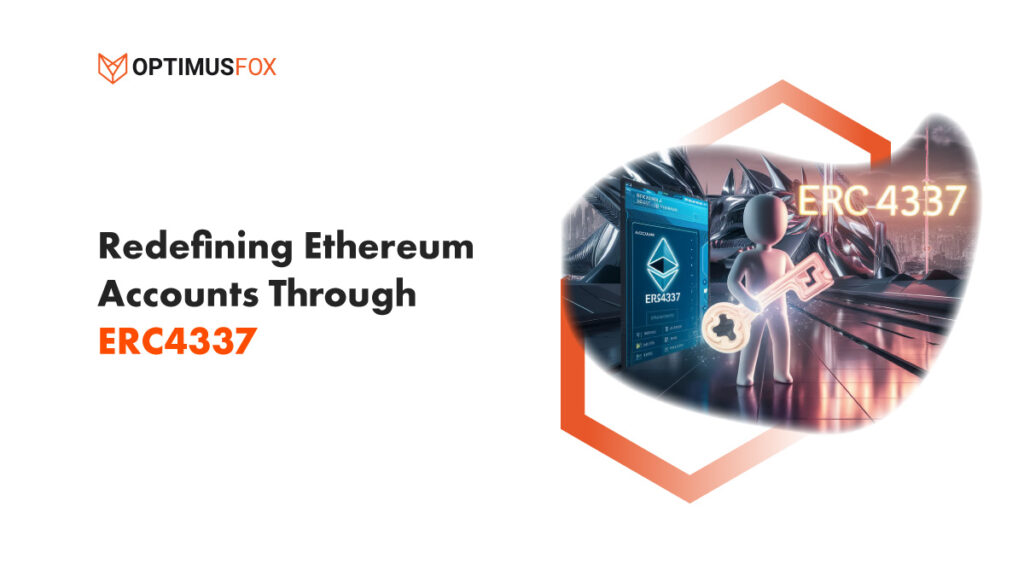Initially, Ethereum used an account-based model with externally-owned accounts (EOAs) controlled by public and private keys, but users needed EOAs to initiate transactions and pay gas fees which involved multiple steps and confirmations, making the process tedious. Losing private keys also meant losing funds permanently. With the introduction of ERC 4337, the creation of smart contract wallets without altering Ethereum’s protocol was now possible. It introduces a “pseudo-transaction” called UserOperation, which can be bundled and processed by the EntryPoint smart contract, streamlining transactions and eliminating private key dependencies.
What is Account Abstraction:
Account abstraction is a method in blockchain where user assets are stored in smart contracts instead of traditional external accounts (EOAs). This turns a crypto wallet into a programmable smart contract. Account abstraction offers a solution by improving the user experience and security of self-custodial wallets, removing reliance on private keys, and making wallets programmable. It also customizes user accounts through smart contracts, reducing risks and enhancing functionality, making it a critical step toward mass adoption of Web3. Blockchain wallets are currently clunky and limited, much like using a flip phone in today’s world. The complexity and security concerns associated with 16-word seed phrases and private keys make it difficult to onboard the next billion users into Web3. The cryptocurrency community believes EOAs limit user interactions with Ethereum, especially for batching transactions and managing gas costs; account abstraction addresses these issues, increasing security and improving user experience by offering features like backup keys, trusted party delegation, and multi-signature requirements. Below are some of the benefits of account abstraction to Web3 segments:
- Smart wallets can create a “white list” of trusted addresses.
- Freeze accounts from another device if the main one is lost.
- Social recovery by pre-approving accounts to authorize new devices.
- Set transaction limits on the amount transferred from an account.
- Hardware Signer: Uses mobile device security chips for transaction signing.
- Multi-call: Batches multiple transactions into one, making them quicker and cheaper.
- Multi-Factor Authentication: Customizable security levels for transactions.
- “Do Not Interact” Lists: Automatically blocks transactions with certain addresses.
- Account Segmentation: Allows for setting withdrawal limits and transaction delays.
Why There is a Need for ERC 4337:
Ethereum account abstraction offers a more user-friendly experience for interacting with decentralized applications (DApps) by storing assets in smart contracts instead of externally-owned accounts (EOAs). While Ethereum supports account abstraction, it is not the default setting, necessitating additional configurations for both users and developers. The introduction of the ERC-4337 standard in March 2023 marked a significant advancement in this area, enabling account abstraction and improving wallet design and user experience through the use of a smart contract called EntryPoint. This innovation is compatible with all Ethereum Virtual Machine (EVM) networks, ensuring broad applicability. ERC-4337 allows for the conversion of traditional wallets into smart contract accounts, significantly enhancing user convenience. By eliminating the reliance on private keys, ERC-4337 mitigates the risk of key loss without necessitating substantial changes to the underlying blockchain. This standard introduces a more efficient way to handle transactions, simplifying the process and reducing the number of steps and confirmations required. As a result, overall efficiency and user satisfaction are greatly enhanced. ERC-4337 transforms the way users interact with Ethereum, making it easier and safer to manage digital assets, thereby addressing critical pain points in the current system and paving the way for broader adoption of blockchain technology.
Here are some of the technical benefits of ERC 4337 integration:
- Eliminates Seed Phrases: ERC 4337 allows users to secure their accounts with familiar and accessible security measures such as two-factor authentication and biometrics, eliminating the need for cumbersome seed phrases. This approach enhances user experience by leveraging widely used and understood security protocols, reducing the risk of losing access to accounts due to misplaced or forgotten seed phrases. The use of biometric data and multi-factor authentication adds an extra layer of security, making it more difficult for unauthorized individuals to gain access.
- Reduces Human Error: Smart contract wallets introduced by ERC 4337 minimize the potential for user mistakes, significantly enhancing security. By automating complex processes and providing clear, user-friendly interfaces, these wallets help prevent common errors such as sending funds to incorrect addresses or mismanaging private keys. This reduction in human error not only safeguards users’ assets but also builds confidence in using blockchain technology, making it more accessible to a broader audience.
- Cross-Chain Compatibility: ERC 4337 offers seamless integration with Ethereum-compatible networks such as Polygon and Avalanche. This cross-chain compatibility allows users to interact with multiple blockchain ecosystems without needing separate wallets or applications for each network. By supporting interoperability, it enhances the flexibility and utility of digital assets, enabling users to take advantage of diverse features and benefits offered by different blockchain platforms. This broad compatibility also promotes greater innovation and collaboration across the blockchain industry.
- Shared Accounts and Multi-User Operations: ERC 4337 supports multi-signature transactions and allows for shared accounts with limited access for multiple users. This feature is particularly useful for organizations and collaborative projects, enabling secure and efficient management of shared assets. With multi-signature functionality, transactions require approval from multiple parties, reducing the risk of unauthorized actions. Limited access controls ensure that users have appropriate permissions based on their roles, enhancing both security and operational efficiency.
Limitations to the ERC 4337 Standard:
Firstly, while ERC 4337 enables the creation of smart contract wallets without altering Ethereum’s core protocol, it still requires additional configurations from both users and developers. This added complexity can be a barrier to adoption, particularly for those new to the blockchain ecosystem. The introduction of “pseudo-transactions” through the UserOperation mechanism, although streamlining the process, might introduce new vectors for vulnerabilities and attacks that need thorough vetting and mitigation. The reliance on the EntryPoint smart contract for bundling and processing transactions could potentially create bottlenecks or single points of failure, impacting the network’s efficiency and security. The transition from traditional externally-owned accounts (EOAs) to account abstraction models might also face resistance due to entrenched practices and the initial learning curve associated with adopting new systems. Finally, while ERC 4337 is compatible with all Ethereum Virtual Machine (EVM) networks, ensuring seamless integration and widespread adoption across diverse platforms might require significant effort and coordination. These challenges highlight the need for ongoing development and community engagement to fully realize the potential benefits of ERC 4337 while addressing its limitations.
Conclusion:
Account abstraction represents a significant shift in blockchain interactions, making them more secure and user-friendly. Ecosystems with native AA support, like Starknet, are at the forefront of this innovation, facilitating widespread adoption. Account abstraction enhances user security and functionality, making it a promising future technology for widespread adoption. It makes it possible for smart contracts to handle transactions more like EOAs, enabling things like batch transactions, where multiple actions are bundled into one. To improve the overall program, ERC 4337 allows more sophisticated security measures in smart contracts with reduction in risk of losing funds through mistakes or hacks. Instead of every transaction being a simple send/receive, user operations can include complex sequences of actions, making the blockchain more efficient. ERC 4337 aims to make Ethereum smarter, safer, and more user-friendly by enhancing how transactions and smart contracts work together.
To learn more about ERC 4337 and how Ethereum is paving a new path for Web3 platforms, contact our technology experts now at info@optimusfox.com





